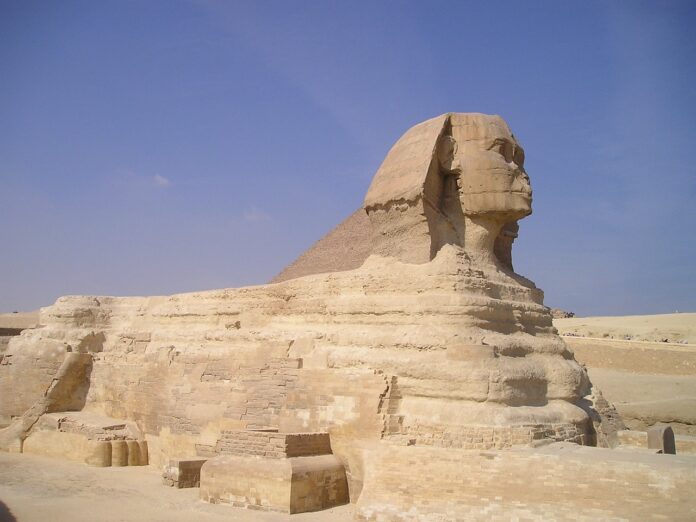The majestic statue of the Great Sphinx, standing on the banks of the Nile, is renowned worldwide. For centuries, it has captivated both scholars and tourists, inviting them to unravel its many mysteries. This is one of the oldest monuments from the ancient world that has survived to this day.
- The Sphinx Had a Temple Dedicated to It Not far from the sculpture, during the reign of Pharaoh Khafre, a temple was built dedicated to the Sphinx. Scholars believe this now-ruined temple was devoted to the sun. The 24 columns symbolize the hours of the day, and two symmetrically located sanctuaries (west and east) align with the equinoxes. During these times, a ray of sunlight would travel in a straight line between the sanctuaries, touch the Sphinx’s shoulder, and move toward the southern corner of Khafre’s pyramid — the point of the sunset.
- The Exact Age is Unknown In ancient times, it was believed that Pharaoh Khafre, who ruled in the 2500s BCE, ordered the construction of the Sphinx. For many centuries, it was assumed that the statue’s face represented Khafre’s features. However, modern computer analysis shows no resemblance between surviving images of Khafre and the Sphinx’s face. Some modern Egyptologists hypothesize that the Sphinx may have been built during the reign of Khufu (Cheops) and might resemble him instead.
- The Sphinx Was Originally Multicolored Originally, the Sphinx was covered in plaster, and its body and face were painted in vibrant colors. Traces of red pigment are still visible on the face, while remnants of yellow and blue remain on the body. People in Cairo worshipped the Sphinx as the lord of the Nile’s floods and regularly cared for the statue, even painting its face with bright red paint until the 16th century CE.
- The Statue Was Buried in Sand Throughout its long existence, the Sphinx was repeatedly buried in sand, with only its head remaining visible. The first recorded excavation occurred during the reign of Thutmose IV in the 14th century BCE. Other efforts to free it from the sand were carried out by Ramses II, the Greeks, Romans, and Arab conquerors. In 1817, Italian archaeologists partially unearthed it, and between 1925 and 1936, the French Egyptologist Émile Baraize led a full excavation. In 2014, the statue was restored and treated with special anti-corrosion substances.
- A Symbol of Royal Power Was Lost During excavations in the early 20th century, the Sphinx lost part of its headdress — the “ureus,” a symbol of pharaonic dignity represented by a cobra. The uraeus symbolized the goddess Wadjet, protector of supreme power, and was typically worn over a royal striped headcloth (nemes) or the double crown.
- The Sphinx Lost Its Nose Contrary to the popular myth that Napoleon’s soldiers shot off the Sphinx’s nose, Egyptologists believe it was actually lost in 1715 during a time of religious upheaval. A Muslim preacher named Muhammad Sa’im al-Dahr was outraged that local farmers were offering gifts to the Sphinx in hopes of a bountiful harvest. Angered by this idol worship, he allegedly destroyed the nose. However, there are no records of how he managed to break it off, and as a result, he was stoned to death by locals.
- The Sphinx Lost Its Beard Scholars suggest that the Great Sphinx did not originally have a ceremonial beard, which may have been added later, possibly during the New Kingdom period. Fragments of the beard were removed due to erosion and are now housed in the British Museum and the Egyptian Museum. French Egyptologist Vassil Dobrev argued that if the beard had been an original feature, its removal would have damaged the chin of the sculpture.
- A Secret Chamber An ancient Egyptian text suggests that the god of wisdom, Thoth, hid sacred books containing secret knowledge in a hidden location and cast magical spells on it. The American mystic Edgar Cayce predicted that a secret chamber lies under the Sphinx’s paw, and books found there would reveal information about a lost civilization. In 1989, Japanese researchers used radar and discovered a narrow tunnel under the left paw of the Sphinx. American geophysicists found a chamber resembling a room, but the Egyptian government has not permitted further exploration.
- The Sphinx May Have a Companion Egyptian archaeologist Bassam El Shammaa claims that a second Sphinx once stood next to the Great Sphinx, depicting a female counterpart. One piece of evidence supporting this theory is a granite stele located between the Sphinx’s front paws, which shows two Sphinx statues.
Another clue is an inscription on a limestone tablet stating that a second Sphinx wore a metal crown, which was struck by lightning, destroying its head. Satellite images from 2006 suggest a carved limestone object lies five meters below the surface, possibly the remains of this second Sphinx.
At night, the Giza Plateau hosts an impressive “Sound and Light” show, where the Sphinx narrates the story of the pharaohs and the construction of the pyramids in multiple languages. Spectacular music, lights, and laser shows make history come to life.
